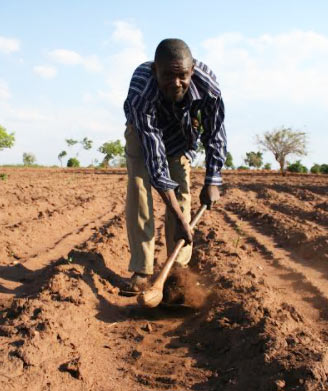The Malawi Forum for Agriculture Advisory Services (MaFAAS) recently participated in a farmer field day organised by the Lilongwe Agricultural Development Division, Lilongwe District Agriculture Office, Mpenu Extension Planning Area and the School for Agriculture and Family Independence (SAFI).
The field day was held under the theme: “Promoting Food and Nutrition through climate smart technologies” and attended by farmers and extension workers from Lilongwe and Ntchisi district, who appreciated and learnt various agricultural technologies that were demonstrated at the event.
Several technologies were showcased by farmers and extension workers such as climate smart technologies being promoted in the area and model house features.
The field day provided a learning and marketing platform for farmers where different extension workers showcased new technologies implemented in their respective sections.

Case of climate smart agriculture: Mr. Mose Chiphikile, a lead farmer and treasurer for NKhanga
Area Stakeholder Panel, showcased pit planting (ulimi wammagodi) plot with good healthy maize cobs. The specifics for planting maize entail digging a small pit measuring 30cm x 30cm wide and 20cm deep with four maize stalks per pit spaced at 25cm apart. The soil in the pit is mixed with manure, certified seeds are used and planted early. Weeding is done on time.
Chiphikile narrated that if farmers practice this kind of farming, they will achieve bumper yields thereby reducing food insecurity and malnutrition.
Chiphikilealso showcased mulching technology which helps during the dry spell by maintaining soil moisture, replenishing soil nutrients through organic matter when the match decomposes and protecting soil against erosion. Furthermore, minimum weeding is required as the mulch suppresses some weeds.

Case of model home
The delegation also appreciated several features for a model home in the village. Mrs. Mambinga, an extension worker, narrated qualities of a good model home. She stated a model home should have a good toilet; a model livestock housing for big and small stock; fruit trees that will act as wind breaks, shading and a source of firewood and fruits and a backyard garden where the waste water for cleaning dishes is used for irrigation.
She added that a home must also have a good kitchen which uses fuel saving technologies and is smoke free.
One of the model house features presented was a livestock pen for small stock. Mrs. Raisi Thebulo showcased a beautiful well-constructed rabbit khola, built using bricks and on bamboo stilts. The rabbit waste drop on the ground and are kept somewhere to be used as manure.

The second model home feature demonstrated was a backyard garden. Mrs. Thebulo highlighted the importance of a backyard garden in food security and nutrition provision. She recommended that women should not spend household income in buying vegetables but should grow their own using simple irrigation using waste water from cleaning dishes. The beds are constructed with bricks to make basins which preserve water and manure.
The manure from livestock is kept around the house and used in the backyard garden instead of inorganic fertilizers. Mrs Mambinga, advised that manure from livestock pens must be kept somewhere where before it is taken to the backyard gardens and the main family fields.
In terms of pest control, flowers grown around the garden act as natural enemies to insect pests. In addition, pests can also be controlled using locally made pesticides which include using donkey dung, neem leaves and garlic instead of industrial chemicals.

The final model home feature showcased was a clean toilet. For effective sanitation farmers were encouraged to have clean sanitary facilities like a good toilet or a pit latrine. Outside the toilet was a hand washing facility called mponda gear and a piece soap hanged to enable hand washing after using the toilet.

Conclusion
It was recommended that organizations should organise joint field days to create wide and robust knowledge sharing platforms. Many extension workers can learn from others how they are implementing activities and also consider taking farmers on learning visits so that technologies can be scaled up and knowledge effectively used.
